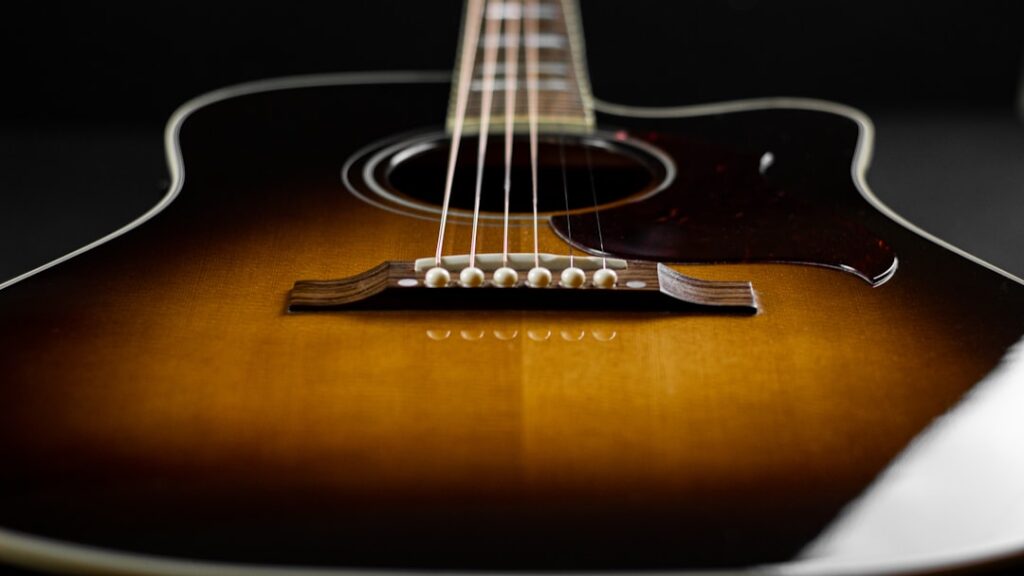When selecting a guitar, several factors should be considered. The type of music and desired sound are primary considerations. Acoustic music may require a steel-string acoustic or classical guitar, while electric guitar players might prefer solid-body or semi-hollow body electric guitars.
Budget is another crucial factor. Guitars are available at various price points, from affordable beginner models to high-end professional instruments. While it’s possible to find decent entry-level guitars at lower prices, investing in a higher-quality instrument can provide long-term benefits.
The size and shape of the guitar are important for player comfort. Those with smaller hands may prefer guitars with smaller necks and bodies, while individuals with larger hands might find larger instruments more suitable. The wood used in guitar construction significantly impacts tone and sound.
Mahogany is known for its warm, rich tone, while maple produces a bright, clear sound. The guitar’s top wood also affects its acoustic properties. Spruce is popular for acoustic guitar tops due to its versatility and balanced sound, while cedar is favored for its warm, mellow tone.
To make the best choice, it’s recommended to try various guitars to determine which feels and sounds most suitable for individual preferences and playing style.
Key Takeaways
- Choose a guitar that feels comfortable and suits your playing style and musical preferences
- Learn the basic techniques of holding the guitar, tuning, and using a pick
- Practice and master common chords and scales to build a strong foundation for playing
- Develop fingerpicking and strumming techniques to add depth and dynamics to your playing
- Explore different guitar styles and genres to expand your musical repertoire and creativity
- Experiment with guitar effects and accessories to enhance your sound and create unique tones
- Dedicate regular practice time and seek feedback to continuously improve and refine your guitar skills
Understanding the Basics of Guitar Playing
Familiarizing Yourself with the Guitar
Before diving into learning chords and scales, it’s essential to understand the basics of guitar playing. First and foremost, it’s crucial to familiarize yourself with the different parts of the guitar, including the body, neck, headstock, frets, and strings. Understanding how these parts work together will help you navigate the instrument more effectively as you begin your journey as a guitarist.
Proper Posture and Hand Positioning
Next, it’s crucial to learn proper posture and hand positioning. This will not only help prevent injury but also improve your playing technique. When sitting, ensure that your back is straight and your shoulders are relaxed. Your strumming hand should be positioned comfortably over the soundhole or bridge of the guitar, while your fretting hand should be able to reach all the frets without straining.
Developing Rhythm and Timing
Additionally, it’s important to develop a good sense of rhythm and timing. This can be achieved through practicing with a metronome or playing along with backing tracks.
Understanding Basic Music Theory
Furthermore, understanding basic music theory is essential for any guitarist. This includes learning about notes, scales, chords, and how they all work together. Familiarizing yourself with the musical alphabet, understanding how to read tablature and chord charts, and learning about rhythm notation are all important aspects of becoming a well-rounded guitarist. By mastering these basics, you’ll be setting yourself up for success as you progress in your guitar playing journey.
Mastering Chords and Scales

Once you have a good grasp of the basics of guitar playing, it’s time to start mastering chords and scales. Chords are the foundation of most songs and learning a variety of chord shapes will allow you to play a wide range of music. Start by learning basic open chords such as C, G, D, E, and As you become more comfortable with these chords, you can move on to barre chords and more complex chord shapes.
Practice transitioning between chords smoothly and accurately to build dexterity and muscle memory. In addition to chords, mastering scales is essential for developing your skills as a guitarist. Scales are sequences of notes played in a specific order and are used as the building blocks for solos and improvisation.
The most common scale for beginners to learn is the pentatonic scale, which is versatile and widely used in many different styles of music. Once you’ve mastered the pentatonic scale, you can move on to learning other scales such as the major scale, natural minor scale, and blues scale. Practicing scales regularly will not only improve your finger dexterity but also help you understand how melodies are constructed.
Furthermore, it’s important to practice chord progressions and scale patterns in different keys. This will help you become more versatile as a guitarist and allow you to play along with a wider variety of songs. By mastering chords and scales in different keys, you’ll be able to expand your musical repertoire and become a more well-rounded musician.
Developing Fingerpicking and Strumming Techniques
| Technique | Description | Benefits |
|---|---|---|
| Fingerpicking | Playing the guitar using individual fingers to pluck the strings | Allows for more intricate and complex patterns, great for folk and classical music |
| Strumming | Using a pick or fingers to brush across the strings in a rhythmic pattern | Creates a full sound, great for accompanying singing or playing in a band |
| Hybrid Picking | Combining fingerpicking and strumming techniques for versatility | Allows for a wider range of sounds and styles, useful for solo performances |
Once you have a good understanding of chords and scales, it’s time to focus on developing your fingerpicking and strumming techniques. Fingerpicking involves plucking the strings with your fingertips rather than using a pick, creating a softer and more intricate sound. To develop fingerpicking skills, start by practicing simple patterns using your thumb and fingers on your picking hand.
As you become more comfortable with fingerpicking, you can start learning more complex patterns and incorporating them into your playing. On the other hand, strumming involves using a pick or your fingers to brush across the strings in a rhythmic pattern. It’s important to practice strumming with both upstrokes and downstrokes to develop a strong sense of rhythm and timing.
Experiment with different strumming patterns and dynamics to add depth and texture to your playing. In addition to fingerpicking and strumming techniques, it’s important to focus on developing good hand coordination. This involves training both hands to work together seamlessly when playing different patterns and rhythms.
Practicing exercises that focus on hand coordination will help improve your overall playing technique and make it easier to tackle more challenging pieces of music. Furthermore, don’t be afraid to experiment with different techniques such as palm muting, hammer-ons, pull-offs, and slides. These techniques can add flair and personality to your playing style and help you stand out as a guitarist.
By dedicating time to developing fingerpicking and strumming techniques, you’ll be well on your way to becoming a versatile and skilled musician.
Exploring Different Guitar Styles and Genres
As you continue to develop your skills as a guitarist, it’s important to explore different guitar styles and genres. Whether you’re interested in rock, blues, jazz, country, or classical music, each genre offers its own unique set of techniques and playing styles. By exploring different genres, you’ll not only expand your musical horizons but also gain valuable insight into different playing techniques.
For example, if you’re interested in rock music, focus on learning power chords, palm muting, and bending techniques commonly used in rock guitar playing. If jazz is more your style, spend time studying jazz chords, arpeggios, and improvisation techniques. Each genre has its own set of challenges and nuances, so don’t be afraid to step out of your comfort zone and try something new.
Additionally, listening to a wide variety of music within each genre can provide inspiration and help you develop your own unique playing style. Pay attention to how different guitarists approach their instrument and try incorporating elements of their playing into your own practice routine. Furthermore, don’t limit yourself to just one genre – experiment with blending different styles together to create something new and exciting.
By exploring different guitar styles and genres, you’ll gain a deeper understanding of music as a whole and become a more versatile guitarist.
Utilizing Guitar Effects and Accessories

Tips for Practicing and Improving Your Guitar Skills
Finally, practicing regularly is essential for improving your guitar skills. Set aside dedicated time each day for practice sessions – even just 15-30 minutes can make a big difference over time. Focus on specific areas of improvement such as chord transitions, scale exercises, or learning new songs.
Additionally, practicing with purpose is key – set specific goals for each practice session and work towards achieving them. Whether it’s mastering a new chord progression or improving your speed on scales, having clear objectives will help keep you motivated and focused during practice. Furthermore, don’t be afraid to seek out resources such as online tutorials, instructional books, or lessons from a qualified instructor.
Learning from others can provide valuable insight into new techniques or approaches that you may not have considered on your own. Lastly, remember that progress takes time – don’t get discouraged if you don’t see immediate results. Consistent practice over time will lead to noticeable improvements in your playing ability.
Stay patient and persistent in your practice routine – before long, you’ll be amazed at how far you’ve come as a guitarist. In conclusion, choosing the right guitar for you is an important first step in your musical journey. Understanding the basics of guitar playing sets the foundation for developing strong skills as a guitarist.
Mastering chords and scales provides the building blocks for creating music on the instrument while developing fingerpicking and strumming techniques adds depth and versatility to your playing style. Exploring different guitar styles and genres allows for creative expression while utilizing effects pedals and accessories enhances your sound. Finally, practicing regularly with purpose is essential for continual improvement as a guitarist.
By following these guidelines and staying dedicated to your craft, you’ll be well on your way to becoming a skilled and versatile musician on the guitar.
If you’re interested in learning more about custom guitar building, be sure to check out Kate Strangfeld’s article on her website www.katestrangfeld.com. Kate is a talented luthier who creates beautiful, handcrafted guitars, and her insights into the art of guitar building are sure to be informative and inspiring for anyone interested in the craft.
FAQs
What is Grote Guitars?
Grote Guitars is a brand that specializes in producing high-quality electric guitars and basses.
Where are Grote Guitars made?
Grote Guitars are manufactured in various locations, including China and Indonesia.
What types of guitars does Grote Guitars produce?
Grote Guitars produces a range of electric guitars and basses, including classic designs and modern variations.
Are Grote Guitars affordable?
Yes, Grote Guitars are known for offering high-quality instruments at affordable prices, making them accessible to a wide range of musicians.
Can I customize a Grote Guitar?
Grote Guitars offers some customization options, such as different finishes and hardware choices, allowing customers to personalize their instruments to some extent.


